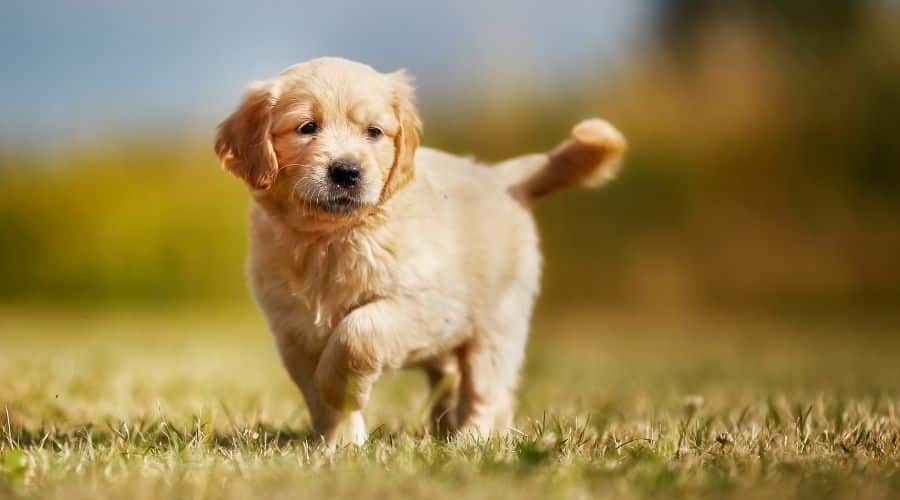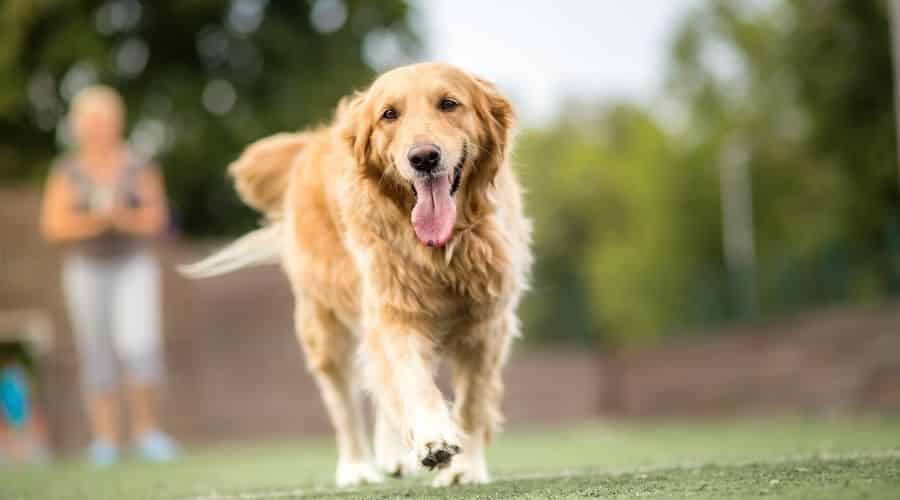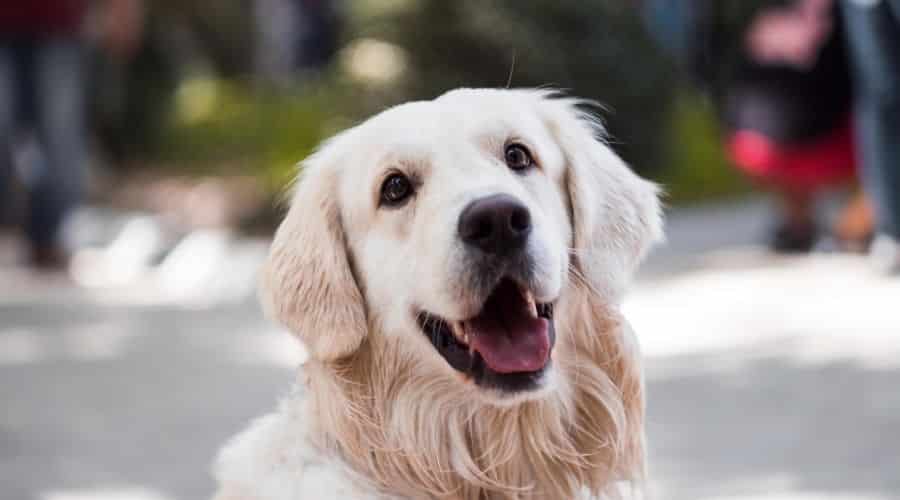Golden Retriever Growth Chart: Male And Female Weight & Height
When you purchase through links on our site, we may earn a commission. Here’s how it works.
Golden Retrievers are known for their big hearts. But they can also become pretty large dogs. This leaves one wondering: “How big do Golden Retrievers get?” And how important is it to monitor how quickly and healthily our puppies are growing? Every dog is an individual, but it’s always good to check averages to see how your pup measures up.
Some Retrievers may grow quicker or slower than others. This can confuse many pet parents. While we know they will be larger than many dogs out there, it’s still worth checking out the growth stages. Points of comparison help us understand how well our dog is doing as they grow. Many different factors go into your Golden’s growth, regardless of gender.
This guide lets you in on all the ins and outs of puppy growth, looking at a month-by-month comparison plus the statistics of an average full-grown Golden Retriever. We also show a chart of your breed’s expected development so that you have a handy reference point. Then we go over the different factors that contribute to your dog’s health as it grows up. Lastly, we explore answers to the most frequently asked questions about Golden Retrievers’ growth. Let’s take a closer look.
Table of Contents
What To Expect

Let’s take a good look at the specifics to expect during their growth period. This helps us prepare for changes as your puppy grows. Growth charts are undoubtedly helpful, but we still need to care for our dogs in the best way possible so that they fill out their bodies nicely. This is also a good time to learn the different developmental changes that happen in your dog’s life during their most crucial developmental stage — puppyhood.
Reminders
This article explores the growth patterns of a typical Golden Retriever. However, remember that your puppy’s results may vary. They may have growth spurts or plateaus that speed up or slow down overall growth. This is normal and is no cause for worry. Retrievers typically reach their full height at around one year old, though their weight continues to develop until they are 18 months old. This growth also depends on nutrition and overall health, so be sure not to overfeed or underfeed your dog. You must also keep them away from injury. Ultimately, your puppy might be a bit smaller or larger than the averages we give. If you find yourself alarmed by this, it’s always a good idea to contact your veterinarian. This gives you the instructions necessary to facilitate proper growth in your pup.
Puppy Growth Timeline
Here is a timeline of your Golden Retriever’s growth, plus the different developmental milestones and things your puppy may need at these times. This breed takes longer to grow than most dogs, so monitor them closely through every growth stage.
Birth To 2 Weeks
From the time your puppy is born to around the two-week mark, they won’t be very interactive because they are blind and deaf. They are also totally reliant on their mother to give them the care they need at this time. If you are caring for the mother, it’s a good idea to keep a close eye on her to make sure that she is eating right. Beyond this, just allow the puppies to suckle the milk they need to their hearts’ content. At around two weeks old, your puppy’s eyes begin to open, and they start hearing sounds.
1 Month
Sometime around one month old, your puppy’s senses have developed a good deal. At this time, they begin to be more social around their littermates. They also have started to wean off their mother’s milk. You can introduce wet food to them at this point. Early socialization is essential, so be sure they’re getting a lot of playtime with their brothers and sisters.
2 Months
At around two months, your puppy can now be separated from its mother. They should be fully weaned off milk at this point. You should now begin obedience training since this is a good time to start it. They are very receptive when very young. This helps set a good foundation for the rest of their lives as well behaved dogs. Housetraining should come easily too. You can expect weight-wise from male and female Golden Retriever puppies. We continue these observations through the rest of this section.
- Males weigh an average of 10 pounds.
- Females weigh an average of 10 pounds.
3 Months
You should continue your puppy’s training and socialization but it may be a good idea to start leash training them now too to get used to the feel of the harness and leash. This is also a good time to get them used to grooming. Consistency and patience are key here, so be sure to treat your puppy fairly. They are very playful and particularly mouthy. Do your best to curb bad behavior and encourage good behavior.
- Males weigh an average of 22 pounds.
- Females weigh an average of 22 pounds.
4 Months
Come four months. Your dog should be happily settled into your home. Socialization and obedience training should continue as usual. It may be a good idea to enroll you both in classes for better help with training. Puppy kindergarten classes are also a good way to instill good behavior in your dog by helping them learn how to behave appropriately around other dogs. This helps them grow into confident adults.
- Males weigh an average of 30 pounds.
- Females weigh an average of 30 pounds.
5 Months
At around five months, you may be astonished at just how large your dog has been getting. It may be more difficult to rein them in when they are rambunctious due to their larger size. This is a stage where they learn, grow, and play at a fast rate. We encourage you to continue with the positive reinforcement, as this can really make all the difference in how your dog grows up. Golden Retrievers grow to be very gentle and loving, but puppies will definitely be puppies. Patience is key here, so try to enjoy them while they’re still little.
- Males weigh an average of 40 pounds.
- Females weigh an average of 40 pounds.
6 Months
When your dog reaches six months old, it will start looking a bit awkward and maybe disproportionate. This is their lanky phase but stick with it because they fill out quickly. They are most susceptible to developing hip dysplasia at around this point, so take care not to overexert them during exercise. Do not go too vigorously when taking them out on walks. The six-month mark should have also established routines. Continue being the firm, confident leader your dog needs in their life.
- Males weigh an average of 44 pounds.
- Females weigh an average of 43 pounds.
7 Months
At seven months old, your puppy should be well accustomed to everyday life with you. Routines should be fleshed out and followed daily. It may be normal for your dog to misbehave sometimes, just to see if they can try it. Therefore, you must remain firm in your discipline while always rewarding good behavior. Socialization continues. They may have found a few new friends while taking walks outdoors.
- Males weigh an average of 48 pounds.
- Females weigh an average of 45 pounds.
8 Months
At around the eight-month mark, you might notice that your Golden has bonded to you quite well. Because of this, they may develop separation anxiety if they are left by themselves for too long of a time. This can lead to destructive behavior and can take a toll on your dog’s mental health. As such, you should always have somebody watching them so they don’t get lonely. Beyond this, your dog should be maturing very well– eating, exercising, and socializing at proper schedules.
- Males weigh an average of 55 pounds.
- Females weigh an average of 52 pounds.
9 Months
You can expect your dog to start behaving a little more maturely at around nine months old. This may not be true for all puppies, as some Retrievers behave like puppies as late as three years old. Still, they are a bit calmer and are happy to behave more, as long as their needs are addressed. Toys are a good way to provide mental and physical stimulation and minimize destructive behavior.
- Males weigh an average of 61 pounds.
- Females weigh an average of 56 pounds.
10 Months
At ten months, your dog is still growing up strong. Since you have established a good rapport with them, they are more inclined to listen to you, though you should still expect plenty of playfulness from these sunshiny dogs. You can start bringing them on longer walks, though you should still take care not to overexert them.
- Males weigh an average of 63 pounds.
- Females weigh an average of 58 pounds.
11 Months
Your dog should be adjusted very well to their life at home with you now that they’re almost a year old. They have become an established member of your family and are happy to play the part. They start to need longer walks, somewhere around an hour a day. They also benefit from playing games with you in the park, as Retrievers are naturally very playful dogs.
- Males weigh an average of 68 pounds.
- Females weigh an average of 63 pounds.
1 Year
Now that your dog has reached their first birthday, home life should be happy and harmonious. Your obedience training has paid off greatly now that they have come to behave and start settling into becoming an adult. It is worth noting that some Retrievers never grow out of their puppy-like exuberance. Continue to support their growth with the proper nutrition. This is when you can start engaging in more strenuous activities. Be sure to get them a checkup for hip dysplasia at around two years old.
- Males weigh an average of 70 pounds.
- Females weigh an average of 65 pounds.
What Happens Next?
At this point, your dog has grown up finely, though they may continue to grow into their bodies weight-wise for another year. You can compare notes with your veterinarian to see how well your dog has grown up. As long as they weren’t overfed or underfed and kept healthy throughout puppyhood, there should be no issue with how large they have gotten.
Full Grown Golden Retriever
Your dog has done a lot of growing during its puppyhood. Male and female dogs have similar weights throughout puppyhood but differ slightly in adulthood. A full grown male weigh around 73 pounds, while females weigh around 70 pounds. Males are also a little bit taller, standing around 23.5 inches at the shoulder, while females average 22 inches in height.

Weight Growth Chart
We’ve put together a growth chart to track your dog’s weight through their puppyhood and up to 2 years old. This resource is a quick reference point that you can keep handy as your dog grows. Just remember that these are averages. Your dog may fall a bit under or over these numbers.
As you can see, your pup has quite a lot of growing up to do. Some months are faster, and some are slower, but they mature nicely at around 70 pounds when they reach two years old. They grow to be quite big dogs, so be sure that you’ve trained them well, so they don’t accidentally topple anyone over.
| Age | Male Weight (lbs.) | Female Weight (lbs.) |
|---|---|---|
| 7 weeks | 9 | 9 |
| 8 weeks | 10 | 10 |
| 9 weeks | 12 | 21 |
| 10 weeks | 15 | 15 |
| 11 weeks | 17 | 17 |
| 3 months | 22 | 22 |
| 4 months | 30 | 30 |
| 5 months | 40 | 40 |
| 6 months | 44 | 43 |
| 7 months | 48 | 45 |
| 8 months | 55 | 52 |
| 9 months | 61 | 56 |
| 10 months | 63 | 58 |
| 11 months | 68 | 63 |
| 1 year | 68 | 65 |
| 2 years | 73 | 70 |
Factors To Consider
Many different factors go into your Golden Retriever’s growth. Understanding each one can help you better understand your dog’s growth and how it may be affected. This can also provide reassurance if the growth milestones are not what you expected.

Genetics
While size is a part of their genetic line, some dogs can be larger or smaller than others. Looking at the parents can usually give you a good idea of how large your dog grows, though this is only an estimation and can be way off the mark. The parents are just a small part of a giant genetic puzzle. They may have genes that result in smaller, average or larger offspring. There is no real way to tell until your dog has reached full maturity. If you prefer, you can always ask your breeder about other offspring their dogs have produced to compare notes.
Nutrition
Nutrition is the foundation of all good health. This is a significant determining factor in how big or small your dog will grow. This does not mean that overfeeding your dog guarantees he will grow as large as healthily possible. This paves the way towards obesity and may even create other orthopedic ailments. Your dog must get enough milk from its mother in the first two months. After being weaned off, they should be eating appropriately sized meals for their age and size. Natural, dog food is the best option for the greatest balance of nutrients necessary for growing bodies. You can also give them vitamins and minerals to help them stay nourished both inside and out.
Growth Spurts And Plateaus
Growth spurts and plateaus can happen at any given time during your dog’s growth. This either speeds up or slows down the growing process. You cannot exactly count on these things to happen when you want to since they occur randomly. Just understand that your dog is doing their best to grow at a healthy pace. Simply doing your best for your dog allows them to grow to its full genetic potential. If you are wary of any changes in your puppy’s growth, it’s always good to ask a veterinarian to see if your pup is developing healthily.
Neutering And Spaying
Spaying or neutering your dog early in its life does not really do anything to stunt its growth. However, their joints may be affected. Some studies show that early neutering or spaying affects your dog’s growth plate. This delays its closure and may make your dog grow taller than it usually would. This can predispose them to joint disease later in their life. Be sure to ask your veterinarian when the best time is to spay or neuter your dog. As a rule of thumb, waiting until your Golden is at least 18 months old is a good time to spay or neuter them. This way, they can finish their version of puberty and adequately develop.
Physical Health
Puppies who were not well for an extended time may have stunted growth. Poor health does not allow the body to reach its highest potential, so you should always check in with your veterinarian to ensure that your puppy is as healthy as possible. Injury can also be a factor in lessened growth in a Retriever. Do not allow them to overexert themselves as they are growing. Always give your dog plenty of space to play so they don’t accidentally bump into anything and hurt themselves in the process.
Frequently Asked Questions

Before we end the article, let’s answer some of the most frequently asked questions that Golden Retriever owners may have about their dogs’ growth. If we didn’t answer your question here, feel free to leave it in the comments below.
When will my Golden Retriever stop growing?
Your Golden grows at a pretty steady pace, ending up being larger than many other dogs. They may act like a puppy for up to three years or even all their lives, but their physical growth stops between 18 months and 2 years. This breed often reaches its adult height around one year old but continues to gain weight until two years of age.
How fast can I expect my Golden Retriever to grow?
They do not grow astonishingly fast, but they still grow fast enough, especially early in puppyhood. During this time, they can sometimes gain 10 pounds in one month, which is quite impressive. They are also susceptible to random growth spurts and plateaus. Just as when we discussed genetics, you can take a lot of the parents to get a rough estimate of how large your dog will grow. However, your mileage may vary. Many dogs start small and then suddenly grow much larger. Conversely, some dogs may begin as massive puppies but eventually hit a plateau and slow their growth. There can be much size discrepancy around this breed, so try not to set too specific expectations.
Will my puppy experience growing pains?
Studies show that puppies do not exactly experience growing pains, but certain orthopedic conditions may give them pain. If you notice limping, swelling, a strange way of movement, and a hesitance to join normally engaging activities, then there may be something wrong. It’s worth going to a veterinarian to get a closer look so that you can sort out whatever it is that is ailing your puppy. It’s also worth noting that your dog can get injured if allowed to play too roughly or exercise too much.
What are some conditions common to growing Golden Retrievers?
One common condition that growing Retrievers may develop is hip dysplasia. This is a condition where the thigh bone does not fit properly into the hip socket. This can cause them pain and lead to degenerative arthritis down the line. You can spot this if you notice your dog limping, standing in an awkward posture, or having a strange gait. Usually, good breeders screen for this disease and do not allow dogs who have the condition to breed.
What do I do if my Golden Retriever isn’t the correct weight?
If you find that your dog is not at the correct weight, there are a few different ways to address this. Their importance always depends on how large they have become size-wise, and dogs tend to get chunkier as they get older. A good test to see if your dog is overweight or underweight is to check its ribs. You should not be able to see them. This is an indicator that your dog is malnourished. You should be able to feel them by lightly touching the ribs. Needing too much pressure means your dog has put on too much weight. Overweight dogs need to go on a well-balanced diet plus engage in more exercise. Underweight dogs require immediate veterinary assistance. They may need deworming in case of internal parasites. Ultimately, you should always consult your veterinarian for treatment plans for overweight or underweight dogs.
Final Thoughts
Golden Retrievers have plenty of growing up to do, so good pet parents should watch to ensure a healthy growth cycle. While there may be a few speed bumps along the way, equipping yourself with the correct information can help smooth things out. Hopefully, this information empowers you to give your dog the best care possible while growing up and throughout their lives.
While there may be many factors in your Retriever’s growth, it doesn’t take much to understand it. You can rest assured that you are giving your dog what they need to grow up healthy and strong. Our final recommendation is to take your dog for its regular vet checkups. Regular check-ins give you the complete picture of how your dog is growing into its full potential.



